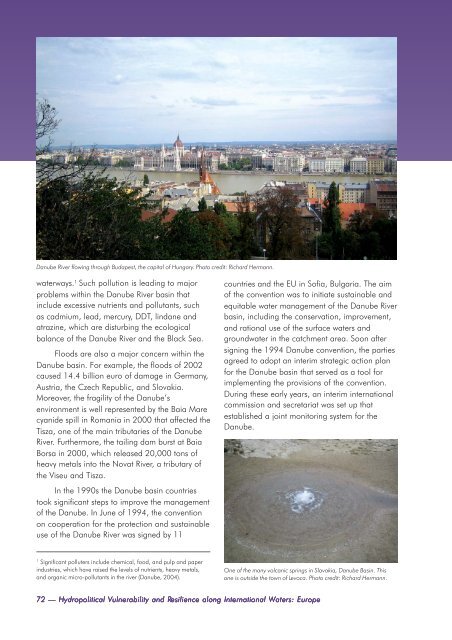Europe - UNEP
Europe - UNEP
Europe - UNEP
You also want an ePaper? Increase the reach of your titles
YUMPU automatically turns print PDFs into web optimized ePapers that Google loves.
Danube River flowing through Budapest, the capital of Hungary. Photo credit: Richard Hermann.<br />
waterways. 1 Such pollution is leading to major<br />
problems within the Danube River basin that<br />
include excessive nutrients and pollutants, such<br />
as cadmium, lead, mercury, DDT, lindane and<br />
atrazine, which are disturbing the ecological<br />
balance of the Danube River and the Black Sea.<br />
Floods are also a major concern within the<br />
Danube basin. For example, the floods of 2002<br />
caused 14.4 billion euro of damage in Germany,<br />
Austria, the Czech Republic, and Slovakia.<br />
Moreover, the fragility of the Danube’s<br />
environment is well represented by the Baia Mare<br />
cyanide spill in Romania in 2000 that affected the<br />
Tisza, one of the main tributaries of the Danube<br />
River. Furthermore, the tailing dam burst at Baia<br />
Borsa in 2000, which released 20,000 tons of<br />
heavy metals into the Novat River, a tributary of<br />
the Viseu and Tisza.<br />
In the 1990s the Danube basin countries<br />
took significant steps to improve the management<br />
of the Danube. In June of 1994, the convention<br />
on cooperation for the protection and sustainable<br />
use of the Danube River was signed by 11<br />
countries and the EU in Sofia, Bulgaria. The aim<br />
of the convention was to initiate sustainable and<br />
equitable water management of the Danube River<br />
basin, including the conservation, improvement,<br />
and rational use of the surface waters and<br />
groundwater in the catchment area. Soon after<br />
signing the 1994 Danube convention, the parties<br />
agreed to adopt an interim strategic action plan<br />
for the Danube basin that served as a tool for<br />
implementing the provisions of the convention.<br />
During these early years, an interim international<br />
commission and secretariat was set up that<br />
established a joint monitoring system for the<br />
Danube.<br />
1<br />
Significant polluters include chemical, food, and pulp and paper<br />
industries, which have raised the levels of nutrients, heavy metals,<br />
and organic micro-pollutants in the river (Danube, 2004).<br />
One of the many volcanic springs in Slovakia, Danube Basin. This<br />
one is outside the town of Levoca. Photo credit: Richard Hermann.<br />
72 — Hydropolitical Vulnerability and Resilience along International Waters: <strong>Europe</strong>
















